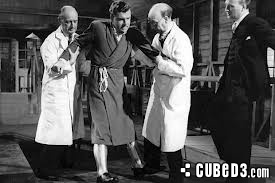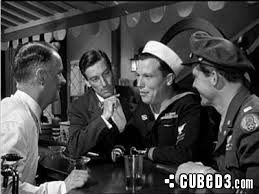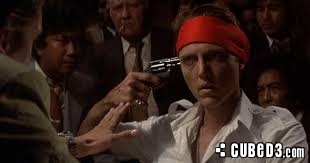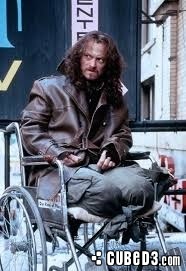 Over the years, many different wars have found their way onto the screen, from Laurence Olivier's morale raising Henry V (1944) at the Battle of Agincourt, through the English Civil War in Cromwell (1970) to the outnumbered British at Rourke's Drift in Zulu (1967) and well beyond, as well as the glut of films about World War II. More recent decades have tended to focus on modern conflicts, such as Vietnam and Afghanistan. However, social changes brought about a different approach to the subject - one that deals with the aftermath as well as the war itself - or instead of it.
Over the years, many different wars have found their way onto the screen, from Laurence Olivier's morale raising Henry V (1944) at the Battle of Agincourt, through the English Civil War in Cromwell (1970) to the outnumbered British at Rourke's Drift in Zulu (1967) and well beyond, as well as the glut of films about World War II. More recent decades have tended to focus on modern conflicts, such as Vietnam and Afghanistan. However, social changes brought about a different approach to the subject - one that deals with the aftermath as well as the war itself - or instead of it.
The most recent example opens this week - Jonathan Teplitsky's The Railway Man, which stars Colin Firth as a traumatised real life POW returning to Burma to confront his past. It might be partly set in World War II,  but its resonances are as contemporary as they come - the treatment of Prisoners of War and, in particular, dealing with the traumatic aftermath at a time when Post-Traumatic Stress Disorder (PTSD) was unheard of. Upper lips were decidedly stiff and getting on with it was the order of the day.
but its resonances are as contemporary as they come - the treatment of Prisoners of War and, in particular, dealing with the traumatic aftermath at a time when Post-Traumatic Stress Disorder (PTSD) was unheard of. Upper lips were decidedly stiff and getting on with it was the order of the day.
Those stiff upper lips, along with a relentlessly positive attitude, were very much to the fore in a British film released from the time when The Railway Man is set. Reach for the Sky (1956) starred Kenneth More as the legendary RAF pilot Douglas Bader who lost both legs in a plane crash, yet still went on to fly during World War II. Viewers see him close to death,  going through rehabilitation and finally walking with artificial legs, but at no point does he ever show any signs of mental trauma. By today's standards, it looks less than credible, even though More's portrayal of Bader is reputed to be an accurate one.
going through rehabilitation and finally walking with artificial legs, but at no point does he ever show any signs of mental trauma. By today's standards, it looks less than credible, even though More's portrayal of Bader is reputed to be an accurate one.
By this stage, though, American film makers had already tapped into the post-war trauma theme, in William Wyler's The Best Years of Our Lives. Released in 1946, with World War II remarkably fresh in audiences' minds, this was an unexpectedly realistic look at three soldiers returning home and trying to cope with civilian life. Physical injury played a leading role here, with real-life war veteran Harold Russell, whose own hands had been replaced by hooks, playing a disabled soldier.
 Fred Zinnemann's The Men (1950) took a similar approach, concentrating again on physical issues. An emergent Marlon Brando plays a paraplegic ex-soldier and, while his emotional difficulties manifest themselves in self-pity at the start of the film, they soon give way to the physical challenges he faces on civvy street.
Fred Zinnemann's The Men (1950) took a similar approach, concentrating again on physical issues. An emergent Marlon Brando plays a paraplegic ex-soldier and, while his emotional difficulties manifest themselves in self-pity at the start of the film, they soon give way to the physical challenges he faces on civvy street.
The shift away from physical problems towards emotional damage went hand-in-hand with the arrival of films about Vietnam, most specifically Michael Cimino's The Deer Hunter (1978). Tracing the lifelong effects of war on three friends - one in a wheelchair, another commits suicide and the third emotionally scarred - it was the first film to examine post-war trauma in some depth.  Interestingly, Robert de Niro had already made Taxi Driver (1976) for Martin Scorcese: his Vietnam vet, Travis Bickle, was clearly suffering from PTSD and The Deer Hunter could almost have been his back story.
Interestingly, Robert de Niro had already made Taxi Driver (1976) for Martin Scorcese: his Vietnam vet, Travis Bickle, was clearly suffering from PTSD and The Deer Hunter could almost have been his back story.
At this point the gates opened, with a flurry of movies dealing with post-war trauma, both mental and physical. Oscar winner Coming Home (1978) was more romantic, with military wife Jane Fonda falling in love with paraplegic veteran Jon Voight. Physical and emotional issues combine in this one: Voight is having to deal with the mental effects of war, as is one of his comrades, who goes on to kill himself. Birdy (1984), Born on the Fourth of July (1989) and even Forrest Gump (1994), were among those that followed, all demonstrating the emotional and, sometimes, physical fall-out from conflict.

 Sign In
Sign In 09.01.2014
09.01.2014 
 jesusraz
jesusraz 
 Link to this post:
Link to this post:  Subscribe to this topic
Subscribe to this topic Features
Features






 Top
Top

